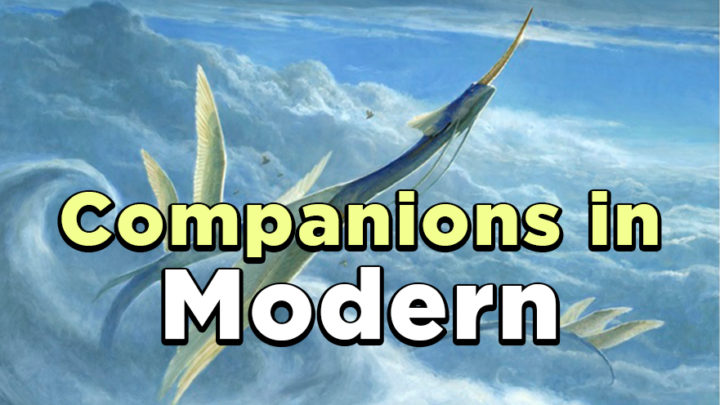Wizards of the Coast released a new banned and restricted announcement this week, including updates to the companion mechanic. Effective June 3rd, companion will work as follows: At any time you could cast a sorcery, you may pay three generic mana to put your companion from your sideboard into your hand. This is a special action, not an activated ability; therefore, it does not use the stack.
This change will add a significant cost to cheaper companions. Decks that previously had to make real sacrifices in order to meet companion requirements now have to weigh whether it’s worth it to include them at all. Lurrus of the Dream-Den previously had a high enough power level to justify contorting your deck to fulfill its requirement, but that may no longer be the case.
Jund, Death’s Shadow, Prowess, Bant Snow, Scapeshift, and Ponza all have some choices to make going forward. Here’s how we expect they’ll shake out.
Jund
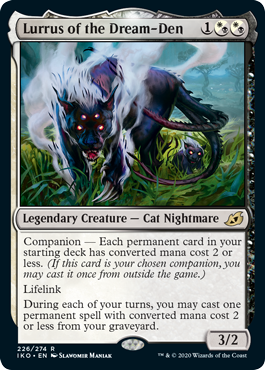
Jund midrange decks took off in Modern following the printing of Lurrus of the Dream-Den. Lurrus found a home in Jund — a deck that prioritizes efficient creatures and removal spells — while also helping its place in the metagame. Jund’s most powerful cards tend to have narrow applications; when the rest of the field becomes homogenized, Jund can adapt and win.
If fewer players choose to play companions, deck selection will diversify — and Jund’s answers will need to diversify as well. As the average converted mana cost of spells increases, Jund will have to turn to Bloodbraid Elf again in order to keep up. Once you’ve committed to ditching Lurrus, you also get to upgrade the copies of Pillage in the sideboard to Fulminator Mage to get some extra value out of Kolaghan’s Command.
If I were playing Jund right after the rules change, I would certainly build my deck with Prowess, Primeval Titan decks, and Big Blue Yorion decks in mind. This means increasing removal density and adding more copies of Thoughtseize back to the list (a 3/3 split of Thoughtseize and Inquisition of Kozilek seems ideal). Boil still seems well positioned out of the sideboard as it handles the Big Blue decks, Temur Scapeshift, and Amulet Titan. If Eldrazi Tron shows up in real numbers, Liliana of the Veil is also a strong option, but one that is less effective against the blue decks, which can generate many more resources than Jund.
Verdict: Jund needs to drop Lurrus and move up the curve to compete with Yorion decks.
Death’s Shadow
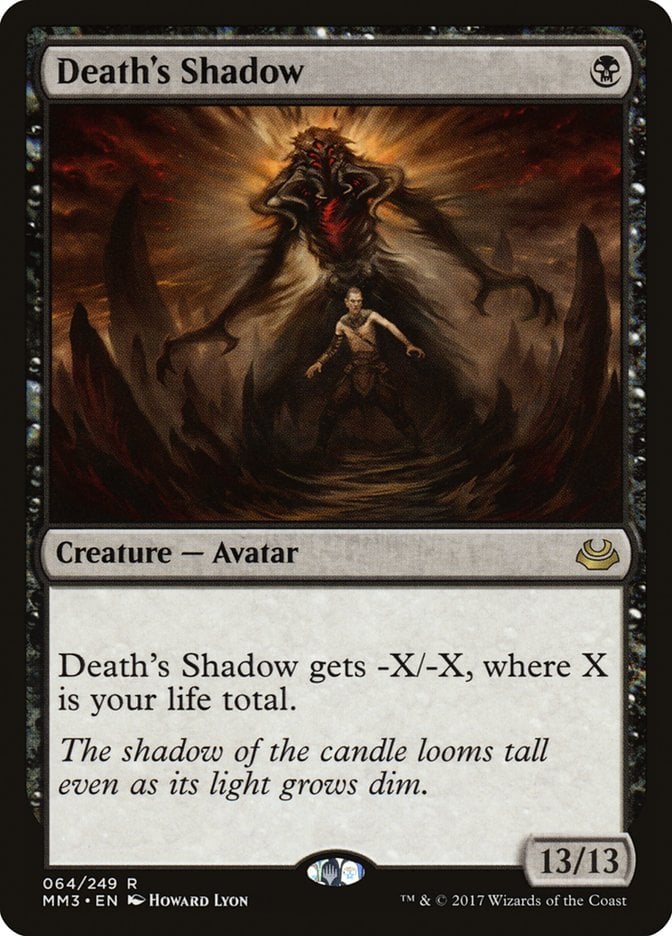
As a Death’s Shadow player, I looked at Lurrus much the same way I looked at Oko. Neither card gelled with the general game plan of Shadow decks, but they were both so powerful that I needed to play them, anyway. The difference is Lurrus asks much more of Death’s Shadow than Oko: giving up Street Wraith and, in many cases, Gurmag Angler slows the deck down considerably. But the new three-mana requirement for companions makes Lurrus a no-go for Shadow decks going forward.
Death’s Shadow is a tempo deck — it wants to get under the opponent and press the advantage. But that was hard to do in a world controlled by Lurrus, where many other decks were operating at Shadow-level efficiency. If the metagame diversifies and players adopt more high-CMC spells again, Death’s Shadow decks will be able to play to their strengths again.
Thoughtseize’s stock goes up now that players must cast companions from their hands instead of their sideboards. Stubborn Denial gets more powerful as the average spell cost increases and Shadow players can leverage a mana advantage over their opponents. Street Wraith and Gurmag Angler puts turn two threats back on the menu, so you’ll have an easier time ending the game before you run out of interaction.
In a world without Lurrus, I can also see the number of incidental graveyard hate cards falling. This could open the door for Kroxa, Titan of Death’s Hunger to help Shadow decks shore up a major weakness against decks that want to play a longer game.
Verdict: Death’s Shadow decks should drop Lurrus and return to their original configuration to capitalize on the slower metagame.
Prowess
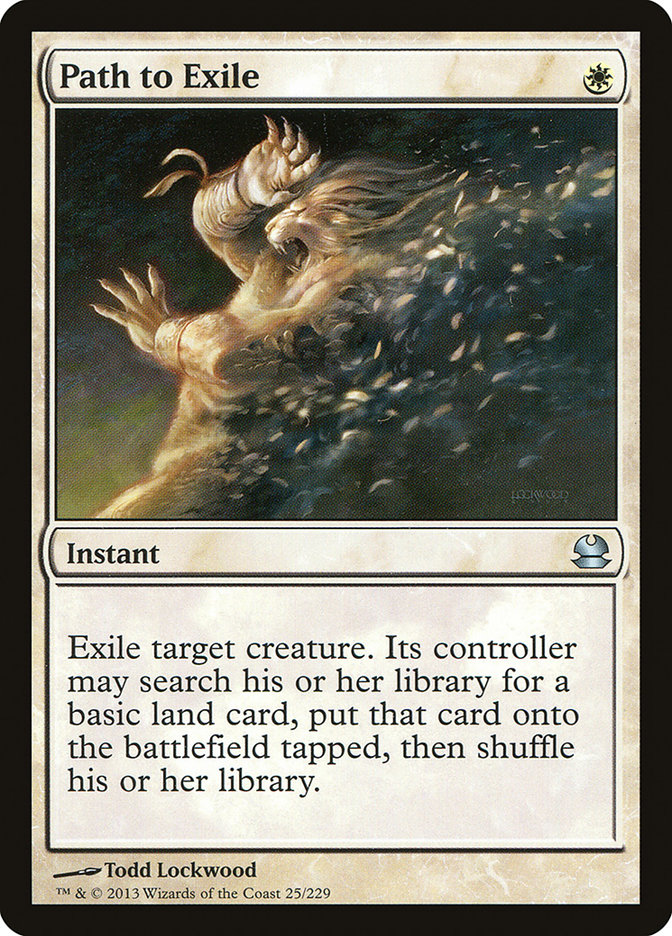
Prowess is one of the few decks in Modern that didn’t have to make any sacrifices to take in the Nightmare Cat. Keeping Lurrus in these lists is a no-brainer, but these decks still have some questions to answer. Should they be Red-Black or Red-White? Should they continue to play Mishra’s Bauble or add additional burn spells to end the game faster?
First, I expect to see more Red-White Prowess decks in the format. As we’ve discussed in the previous sections, the average CMC of creatures in Modern should increase with this change, so Fatal Push — a major reason to play black — will be less effective than usual. Meanwhile, Path to Exile is set to trend upward in value as more Uros and Primeval Titans enter the fray.
Second, if Modern sizes up, Prowess decks should prioritize getting under opponents and deprioritize interaction; therefore, it would make sense to add more burn spells to lists. Additionally, Mishra’s Bauble loses some of its power if Lurrus moves into more of a supportive role in these decks. Prowess won’t be casting Lurrus until much later in the game, when buying back a creature is much more valuable than drawing a random card with Bauble.
Verdict: Lurrus is an easy keep for the Prowess decks because the opportunity cost is playing it is so low, but it will likely serve a different role.
Bant Snow
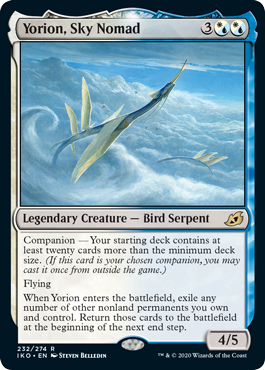
Bant Snow decks were already among the best in Modern before the companion change, and I expect them to gain a tighter hold now. Yorion made it out of the companion crackdown largely unscathed, while most of its competition took quite a hit. Decks playing Yorion already have an interest in prolonging the game, and paying three mana to add a five-mana 4/5 flyer that draws five cards to your hand isn’t much of a cost. Bant Snow decks, like all reactive decks in Modern, will need to adapt to other changes in the format, but they’ll undergo a much more subtle transformation than other decks.
Verdict: Bant Snow will keep Yorion and will likely be the best deck in Modern for the time being.
Scapeshift
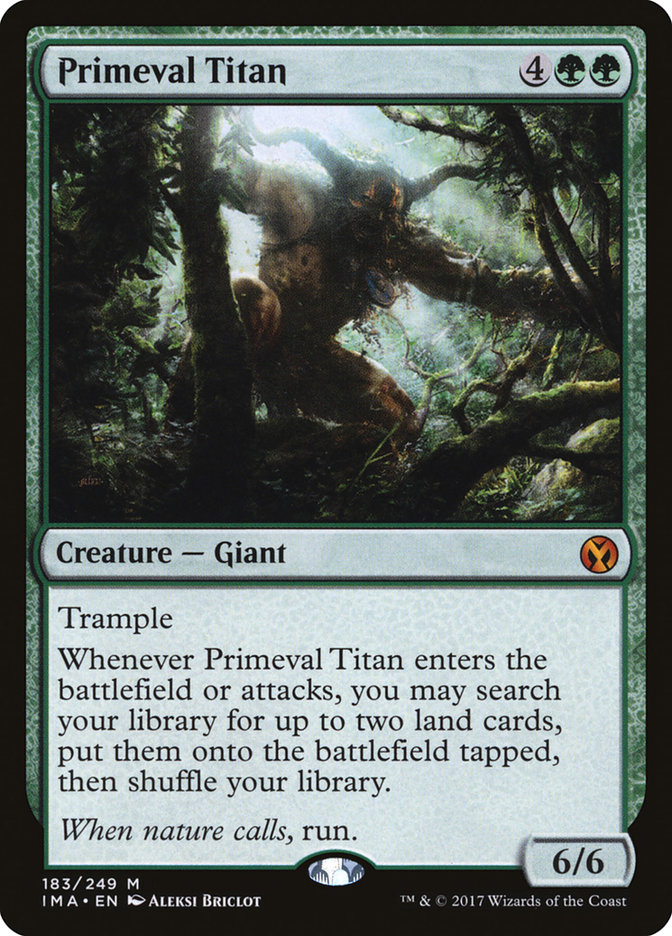
While players initially balked at playing 80 cards when Yorion came along, some Scapeshift players were used to playing more than 60 for the sake of their mana bases. With the addition of Yorion, we saw a move from the raw speed of Titanshift to a more interactive Temur Scapeshift to support blue mana for Yorion. And with the addition of blue mana, Scapeshift also got access to Uro, Ice-Fang Coatl, and Cryptic Command.
Temur Scapeshift uses Yorion differently than most other Yorion decks. It isn’t always a dedicated value card, but a tool to slow the game down long enough for you to combo. Plus, you can always sneak a hit in to drop the opponent below 18 life to enable a lethal Scapeshift on seven lands instead of eight. But tacking three mana onto Yorion’s casting cost may make it less effective as a speed bump during the mid-game, so Scapeshift decks will need to reconsider whether the cost is worth it.
Verdict: The jury’s out on this one. If Modern becomes slower and Scapeshift decks need to be more interactive, Yorion still seems completely viable. On the other hand, if Modern rewards speed, we could see the return of Red-Green Titanshift.
Ponza
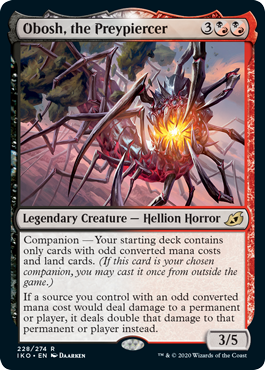
Obosh, the Preypiercer has been a go-to finisher for Ponza decks. Most of the power in Ponza lies in the three-mana slot in the curve, in cards like Blood Moon and Pillage; Ponza already wanted to use Arbor Elf and Utopia Sprawl to jump from one to three, anyway, so adding Obosh was never a huge cost to play it in the first place. The two- and four-mana spells in Ponza weren’t a huge loss, as the twos weren’t all that impactful, and the difference between the fours and the fives isn’t that large. Ponza with Obosh has gaps built into their curve, especially at four mana; that would be an excellent time to pay the new companion tax to add Obosh to your hand. In fact, Ponza decks are primed for a comeback should Scapeshift and other “big mana” decks start to dominate.
Verdict: Ponza decks should keep Obosh; it increases the deck’s damage output at a minimal opportunity cost. However, if a more enticing two- or four-mana card comes along, Obosh may no longer fit.
I, for one, am excited to play Modern again after the companion change and hope it will open up space for new decks to emerge. I’m also excited to see which other decks pick up or put down companions going forward, and how this change will shape Modern. If you have any cool ideas, be sure to let me know on Twitter at @RappaciousOne!

Michael Rapp is a Modern specialist who favors Thoughtseize decks. Magic sates his desire for competition and constant improvement.

